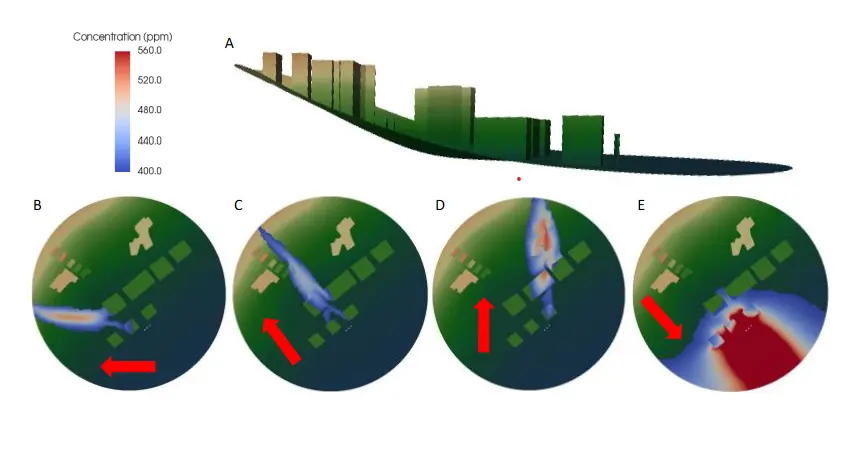CFD Model of Exhaust Emission Pollutants in Tromsø Harbor

B) West, C) North-West, D) North and E) South-East. The pollutant deposition in the sea, E, is enhanced by the lack of orographic obstacles to the wind, as compared to C where the wind blows uphill inland.
Plume emissions from industrial activities and chimneys of large boats can carry several pollutants to the nearby cities causing a detrimental effect on the life quality and health of local citizens and ecosystems. They are transported by the local wind over habited areas and traces of it will reach the street level, leading to contamination of the air. The main pollutants are waste products of industrial activity or the combustion processes emitted in the gas phase or as particulate matter. Gas phase pollutants diffuse in the surrounding air and they are transported by the wind flow over habited areas. The local level of contamination is difficult to assess without real-scale atmospheric simulations. A realistic simulation model should describe the atmospheric conditions (temperature, wind, pressure), the local topography and the characteristics of the emission plume (temperature, combustion by-products, height of chimney).
The main pollutants are waste products of industrial activity or the combustion processes, mainly carbon monoxide, nitrogen and sulfur oxides in the gas phase and solid particulate matter. Carbon dioxide is the main by-product of exhaust plumes. Although it does not have any health effects, the fluid-dynamics behaviour of CO2 is comparable to and representative of any gas pollutant in the plume. In the present work, we have made a comprehensive study of the effect that plumes from the harbour of Tromsø (Norway) have on the contamination levels in the city. We have used computational fluid dynamics modelling of transport and diffusion in air. OpenFOAM has been used for the simulation of the gas mixture. The Navier-Stokes equation has been solved including the compressibility effects of perfect gases and buoyancy effects. Turbulence effects have been treated using Reynolds Averaged Navier– Stokes (RANS) models. The online platform KALEIDOSIM® has been used to run large parameter studies simultaneously, improving noticeably the workflow. High wind speed and chimney height are seen to be the main factor decreasing the pollutant concentration in the surrounding area of the emission plume. On the other hand, the wind direction determines which zones are more affected by the plume emissions. The local orography also has a large effect on the gas flow and can enhance or deplete the deposition of emission gases. The presented results will help to evaluate the impact of pollutants in the everyday life of local citizens.